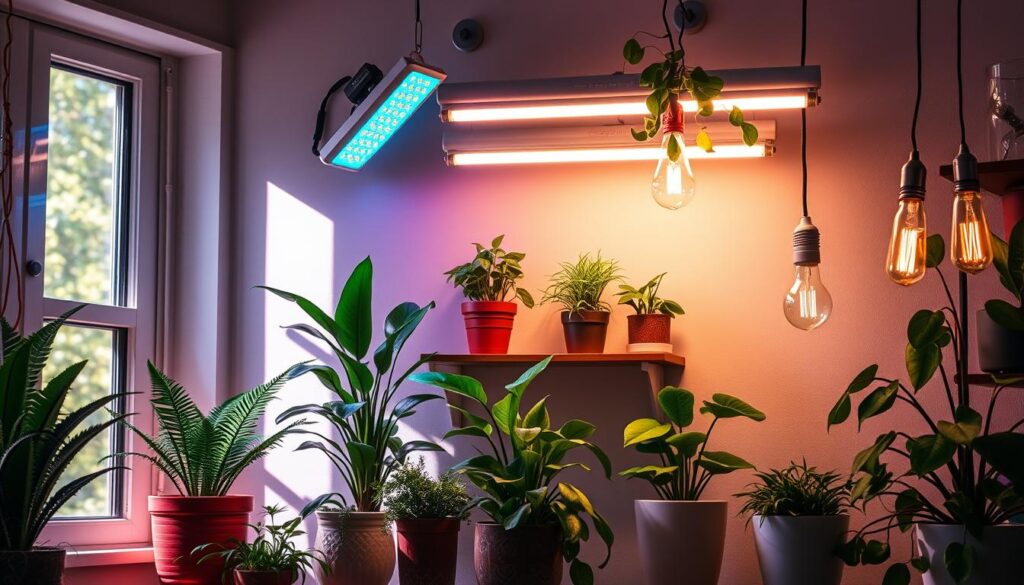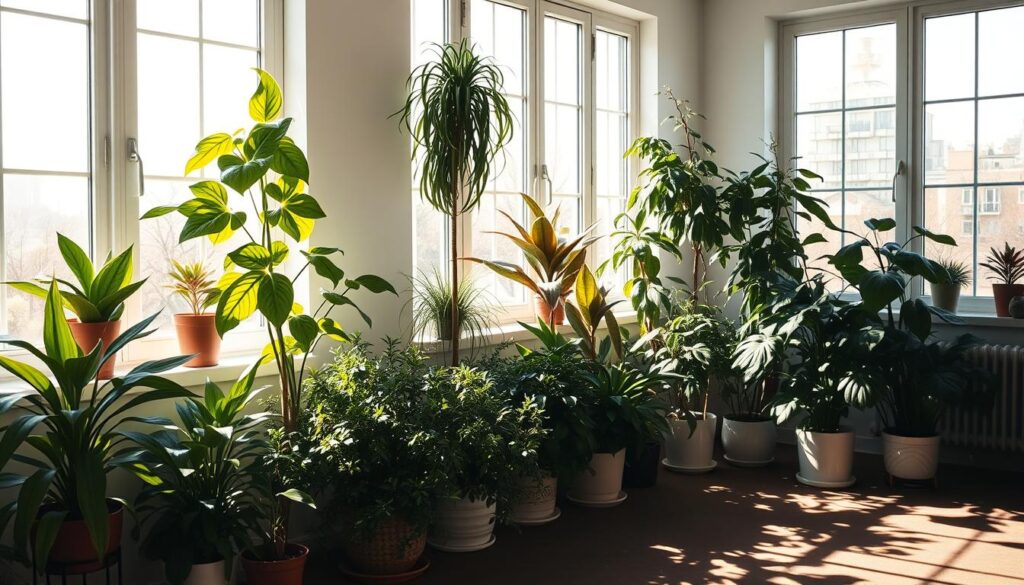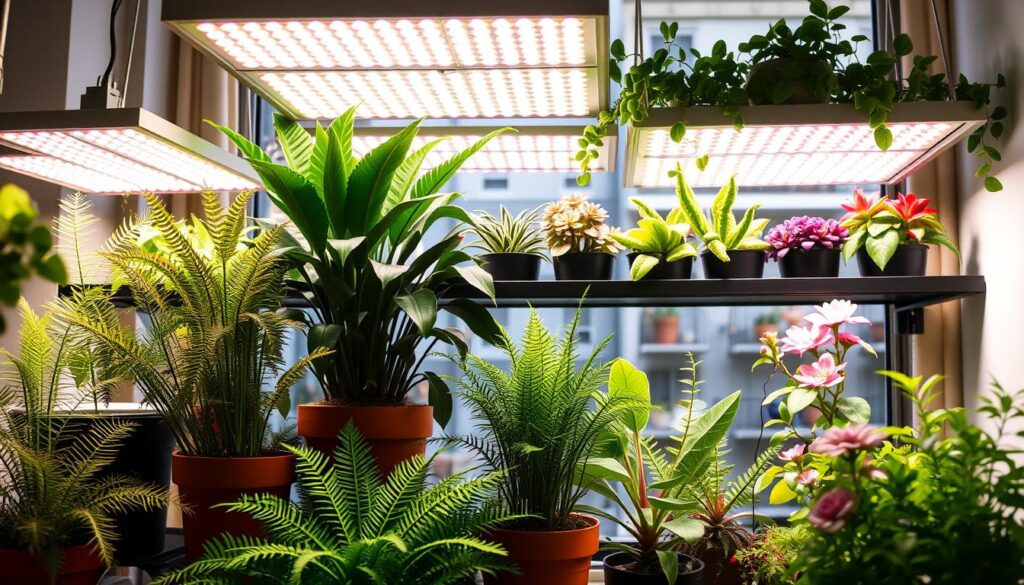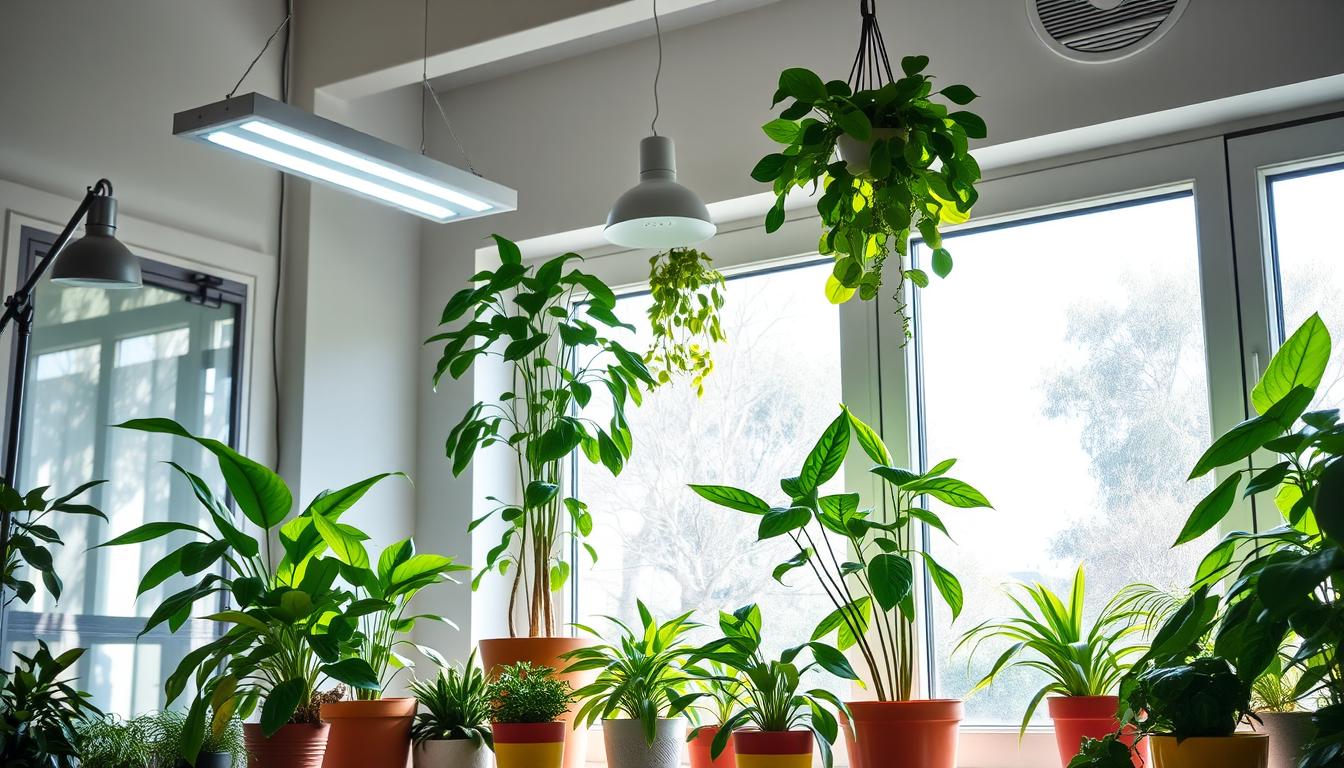Proper lighting is key for indoor plants to thrive. This guide will cover the the ultimate guide to indoor plant lighting. It will also discuss the various types of indoor gardening lights. You’ll learn how to check and improve light in your home for your indoor garden.
It’s perfect for those facing low-light issues or wanting the best for their plants. This guide has everything you need.
Key Takeaways
- Proper lighting is essential for the health and growth of indoor plants
- This guide covers the importance of light for plants, different types of grow lights for houseplants, and how to optimize light conditions
- Learn about the best led grow lights for indoor plants and artificial lighting for plants indoors
- Discover solutions for supplemental lighting for low-light houseplants and understanding the optimal light requirements for indoor plants
- Become an expert in indoor plant lighting requirements and indoor plant lighting systems
Understanding the Importance of Light for Indoor Plants
Houseplants and indoor plants make our living spaces better and more lively. But, they need the right amount of light to stay healthy and grow well. Light is key for photosynthesis, which helps plants make the food they need to live and grow.
Photosynthesis and Plant Growth
Photosynthesis turns sunlight, water, and carbon dioxide into glucose. This glucose is the food that helps plants grow and develop. Having enough good light is crucial for this process. It affects how healthy and strong indoor plants can be.
Different Light Requirements for Different Plants
- Some houseplants, like succulents and cacti, love bright sunlight. Others, like ferns and philodendrons, do better in soft, filtered light.
- It’s important to know what each indoor plant needs for light to keep them healthy and growing well.
- The type of plant, its leaves, and how it grows affect its light needs.
By understanding how light affects plants, you can make your indoor garden beautiful and full of life.
“Light is the lifeblood of plants, enabling the process of photosynthesis that allows them to create the sugars and energy they need to grow and thrive.”
Types of Light for Indoor Plants
Understanding the different types of light is key to keeping indoor plants healthy. Natural sunlight is a main source of light that helps your plants thrive.
Natural Sunlight
Natural sunlight comes in three main types: direct, indirect, and filtered. Direct sunlight is the strongest, shining straight onto plants. Indirect sunlight is softer, coming after bouncing off things. Filtered sunlight goes through things like windows or curtains, giving a gentler light.
Each type of sunlight is good for different plants. Knowing what your plants need can help them grow better.
| Type of Natural Sunlight | Description | Suitability for Indoor Plants |
|---|---|---|
| Direct Sunlight | Unobstructed, intense rays of the sun | Suitable for sun-loving plants that thrive in bright, direct light |
| Indirect Sunlight | Diffused, reflected, or scattered light | Ideal for plants that prefer moderate, even lighting conditions |
| Filtered Sunlight | Light that passes through a medium, such as a window or curtain | Suitable for plants that require less intense, softer lighting |
If natural sunlight is scarce, grow lights like LED grow lights and fluorescent grow lights can help. They give your plants the light they need to grow well.

Assessing and Optimizing Light Conditions in Your Home
First, check the light in your home to make sure your indoor plants get enough light. Look at the window orientation, if trees or buildings block the view, and how bright the light is during the day. Use this info to place your plants right and add supplemental lighting if needed to meet their needs.
Analyzing Natural Light Sources
Examine the natural light in your home. See how the light changes during the day and note where it’s high, low, or medium. This will guide you in picking the best spots for your plants.
- Find out which way your windows face (north, south, east, or west) and how it affects the quality and intensity of natural light they get.
- Think about any things that might block or change the natural light coming into your home, like trees or shades.
- Notice how light levels change in different rooms and at different times of day.
Incorporating Artificial Lighting
If your home doesn’t get enough natural light or if your plants need special lighting, you might need artificial lighting. Pick the right kind and place of lights to improve the light for your indoor plants.
| Light Condition | Recommended Lighting |
|---|---|
| Low-light | Fluorescent or LED bulbs with a warm color temperature (2700-3000K) |
| Medium-light | Compact fluorescent or LED bulbs with a medium color temperature (3500-4100K) |
| High-light | LED grow lights or high-intensity fluorescent bulbs with a cool color temperature (5000-6500K) |
By checking the light in your home and improving it for your indoor plants, you can make the best space for them to grow.

The Ultimate Guide to Indoor Plant Lighting
This guide covers the key parts of indoor plant lighting. We’ve looked at why light is vital for plant health and how to improve your home’s light for plants. Whether using natural sunlight or artificial grow lights, the goal is to give plants the right light for their needs.
Photosynthesis is key to plant growth. So, making sure your indoor plants get the right light spectrum and intensity is crucial. By using the tips from this guide, you can make your indoor garden thrive with the right lighting.
Choosing the Right Grow Lights for Your Plants
There are many artificial plant lighting options, each with pros and cons. LED grow lights are popular for being energy-efficient and lasting a long time. They also give plants the light they need. Fluorescent grow lights are cheaper but might not save as much energy as LEDs.
It’s important to pick a grow light that gives full-spectrum lighting for your plants. This means they get the red, blue, and UV and infrared light they need for healthy growth and development.
Optimizing Light Conditions for Healthier Plants
Picking the right grow lights is just the start. You also need to adjust the light’s placement and intensity for your plants. This might mean changing the light’s height, adding extra light in certain spots, or mixing natural and artificial light for the best effect.
By following this guide, you can optimize the lighting conditions for your indoor plants. This will help you create a lush, healthy indoor garden with the right amount of light.

“Proper lighting is essential for the health and growth of indoor plants. By providing the right type and amount of illumination, you can create a lush, thriving indoor oasis.”
| Light Source | Advantages | Disadvantages |
|---|---|---|
| LED Grow Lights |
|
|
| Fluorescent Grow Lights |
|
|
Conclusion
In this guide, we’ve looked at how important light is for indoor plant lighting and houseplants. We covered the science of photosynthesis and plant growth and the light needs of various indoor plants. We talked about the perks of natural sunlight and how to use artificial lighting with grow lights. This guide gives you the key info to make a great indoor garden.
With the tips from this article, you can improve the lighting conditions at home. This ensures your houseplants get the best light to grow well. You can use natural lighting or add artificial grow lights. This guide has given you the tools for a lush, vibrant, and healthy indoor oasis.
The secret to great indoor plant lighting is knowing what your houseplants need and adjusting your lighting. By getting good at optimal lighting for your indoor garden, you’ll enjoy the many perks of thriving indoor plants. Happy gardening!
FAQ
Q: What is the importance of light for indoor plants?
A: Light is key for photosynthesis, helping plants make sugars and energy. Each plant type has its own light needs, based on where it grows naturally. Knowing what light your indoor plants need is vital for their health.
Q: What are the different types of light that impact indoor plants?
A: Indoor plants get light from natural sunlight and artificial sources. Natural light comes in direct, indirect, and filtered types, each fitting different plants. When sunlight is scarce, grow lights can help plants grow well.
Q: How do I assess and optimize the light conditions in my home for my indoor plants?
A: Start by checking your home’s light conditions for your plants. Look at your windows, any trees or buildings blocking light, and how much sunlight you get each day. Use this info to place your plants right and add grow lights if needed.
Q: What are the best lighting solutions for indoor plants?
A: For indoor plants, you can use natural sunlight or various grow lights. Options include LED, full-spectrum, and fluorescent grow lights. These can help make the best light conditions for your plants.
Q: How do I determine the light requirements for different indoor plant species?
A: Plants need different amounts of light based on where they grow naturally. Some like bright sunlight, while others do well in softer light. Knowing what your plants need helps you give them the right light for growth.






